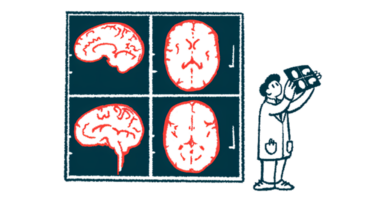Lcn-2 Protein Marks Intestinal Inflammation in MS, Study Shows
Gut microbiome changes could contribute to disease development

People with relapsing-remitting multiple sclerosis (RRMS) have elevated levels of the lipocalin 2 (Lcn-2) protein in their stool samples, a marker for intestinal inflammation, compared with healthy controls, a study demonstrated.
Among patients, findings also demonstrated those with high fecal Lcn-2 had changes in their gut microbiome, the collection of bacteria and other microorganisms in the human digestive tract, including a reduction in gut bacteria known to actively suppress intestinal inflammation by breaking down dietary fiber.
Although more studies are needed in patients, analyses in mice demonstrated elevated fecal Lcn-2 preceded the onset of multiple sclerosis (MS)-like disease, indicating gut inflammation and changes in the gut microbiome may contribute to disease development.
“Fecal Lcn-2 level is a sensitive biological indicator for gut [alterations] in multiple sclerosis,” the researchers wrote. Future studies are needed to explore a link between fecal Lcn-2 and clinical measures, including MS relapse rate and disease progression, they noted.
While this study does not address dietary fiber as a treatment for gut changes and inflammation in MS, investigators at Rutgers Robert Wood Johnson Medical School, in New Jersey, are enrolling MS patients in a Phase 1/2 clinical trial (NCT04574024) to assess the impact of high-fiber supplementation on the gut microbiome and immune system, according to a university press release.
The biomarker study, “Fecal Lcn-2 level is a sensitive biological indicator for gut dysbiosis and intestinal inflammation in multiple sclerosis,” was published in the journal Frontiers in Immunology.
MS has been linked with inflammation of the intestines and gut dysbiosis, a broad term defined as the imbalance in the microbes that inhabit the digestive system, associated with an unhealthy outcome. As such, it has been suggested poor diet may contribute to MS development and severity.
“Unhealthy dietary habits such as low fiber and high fat consumption may have contributed to the steep rise of MS in the U.S.,” said Kouichi Ito, PhD, an associate professor of neurology at Rutgers and study co-senior author. “In nations where people still eat more fiber, MS is far less common.”
MS mice models had inflammation, sores in digestive track
To shed light on the underlying mechanisms of MS-linked gut inflammation, the Rutgers team first investigated an MS mouse model that spontaneously developed experimental autoimmune encephalomyelitis (EAE) — an artificially induced disease of the brain and spinal cord that resembles MS.
The cells lining the large intestine of these mice showed a marked increase in numbers, coinciding with swelling of the colon tissue, a sign of chronic colitis — a type of inflammatory bowel disease (IBD) marked by inflammation and sores in the digestive tract. During the onset of intestinal inflammation, there was a massive influx of immune neutrophils, a type of white blood cell.
Because neutrophils are known to secret the anti-microbial protein Lcn-2, which has been used as a sensitive biomarker of intestinal inflammation, the team measured fecal Lcn-2 levels in these animals. Lcn-2 was associated with the development of EAE, with its levels increasing one week before symptom onset.
“These data highlight the coincident development of [brain/spinal cord] and gut inflammation in [EAE] mice,” the team wrote. “Since fecal Lcn-2 levels were increased before EAE onset, intestinal inflammation probably preceded the onset of EAE.”
To determine whether the same process occurs in people with MS, blood and stool samples were collected and analyzed from RRMS patients and unaffected donors. One person from each group ate a vegetarian diet, while all other participants ate a so-called western diet.
Like in mice, fecal Lcn-2 levels were significantly higher in the RRMS group than in the control group. At the same time, elevated Lcn-2 significantly correlated with a decrease in microbial diversity. Elevated markers for intestinal inflammation also correlated significantly with higher fecal Lcn-2 levels and lower microbial diversity.
“Collectively, these data suggest that increase in fecal Lcn-2 levels is associated with gut dysbiosis in MS patients,” the team added.
Microbial composition of RMMS patients examined
The team then explored the gut microbial composition of RRMS patients and its relationship to fecal Lcn-2.
Certain bacteria in the gut ferment dietary fiber into molecules called short-chain fatty acids (SCFAs), which directly interact with the immune cells to suppress intestinal inflammation. Analysis showed RRMS patients had lower numbers of these beneficial bacteria compared with controls, and the bacteria were especially depleted in patients with higher fecal Lcn-2.
Among MS-associated gut bacteria, a decrease in the abundance of one species called Blautia massiliensis was significantly associated with lower blood SCFAs.
Since this bacteria is highly abundant in the gut — the third most abundant bacteria and more than twice as abundant in controls versus RRMS — its “reduced abundance in MS may significantly impact the reduction in blood SCFA levels mediated by underlying intestinal inflammation,” the researchers wrote.
“The observations we describe in MS patients support the findings in EAE and indicate that fecal Lcn-2 is a sensitive biological marker for gut dysbiosis in MS,” the researchers concluded. “In the future, it is important to explore the association between fecal Lcn-2 levels and clinical parameters including MS relapse rate and disease progression in a larger sample size prospective [forward in time] study.”







